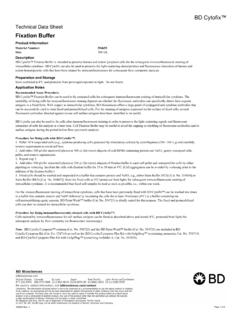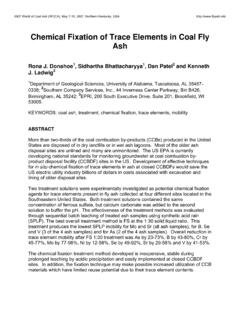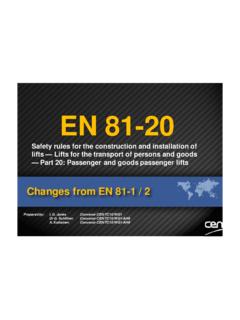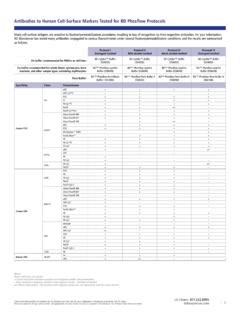Transcription of Mouse Th1/Th2/Th17 Phenotyping Kit - bdj.co.jp
1 BD Pharmingen Technical Data SheetMouse Th1/Th2/Th17 Phenotyping KitProduct InformationMaterial Number:560758 Size: 50 testsDescriptionComponents:51-9006631 Mouse Th1/Th2/Th17 Phenotyping ml Containing the following: MS CD4 Clone: RM4-5 MS IL-17A PE Clone: MS IFN-GMA FITC Clone: MS IL-4 APC Clone: 11B1151-9006613BD Cytofix Fixation Buffer100 ml51-2091 KEBD Perm/Wash Buffer25 ml51-2092KZ BD GolgiStop Protein Transport Inhibitor (containing monensin) mlThe peripheral CD4+ T cell pool includes multiple effector and memory T cell subsets that arise through antigen-driven expansion and differentiation of na ve T cells.
2 The early response of na ve CD4+ T cells to antigenic stimulation is characterized by high level proliferation and a limited cytokine repertoire. Further differentiation yields cells with a more diverse potential for cytokine expression. Depending upon the balance of local cytokines, costimulatory molecules, antigen levels, and genetic factors, Type-1 T helper (Th1), Th2, and Th17 effector and/or memory cells are generated by immune responses. Functionally-polarized CD4+ T cell subsets have been identified based on their distinctive patterns of cytokine secretion. As a signature cytokine, Th1 cells selectively produce large amounts of interferon-gamma (IFN- ). Th2 cells selectively produce IL-4, and Th17 express high levels of IL-17A.
3 Through secretion of IFN- and other effector molecules, Th1 cells activate macrophages, natural killer (NK) cells, and CD8+ T cells and are responsible for cell-mediated immunity. Th1 cells provide protection against intracellular bacteria, fungi, protozoa and viruses and are involved in some autoimmune responses. IL-4 produced by Th2 cells is particularly strong in driving B cells to generate IgE-secreting cells. IgE plays a role in basophil/mast cell mediated immune reactions. Th2 cells mediate protection against extracellular parasites but may also cause harmful allergic responsiveness to develop. Through the secretion of IL-17A and other factors, Th17 cells recruit and activate neutrophils and mediate immune responses against extracellular bacteria and fungi.
4 Th17 cells are also implicated in autoimmune responses. In addition to these types of T helper cells, Th0- (IL-4 and IFN- ) and Th17/Th1-like (IL-17A/IFN- ) cells that coexpress signature cytokines have been Th1/Th2/Th17 paradigm provides a useful model system for investigating the cellular and molecular mechanisms that mediate protective as well as harmful immune responses. The BD Mouse Th1/Th2/Th17 Phenotyping Kit provides an easy-to-use four-color cocktail of fluorescent antibodies-specific for Mouse CD4, IFN- (for Th1), IL-4 (for Th2) and IL-17A (for Th17)-that will enable researchers to identify and characterize the nature of these T helper cell types by multicolor flow cytometric analysis.
5 The kit can be used to successfully analyze ex vivo lymphoid cell samples (eg, for the types of in vivo-generated T helper cells) or to monitor T helper cell differentiation by cells cultured within various experimental model Rev. 4 Page 1 of 5 Preparation and StorageThe monoclonal antibody was purified from tissue culture supernatant or ascites by affinity antibody was conjugated to APC under optimum conditions, and unconjugated antibody and free APC were antibody was conjugated with R-PE under optimum conditions, and unconjugated antibody and free PE were antibody was conjugated with under optimum conditions, and unconjugated antibody and free were removed.
6 Storage of conjugates in unoptimized diluent is not recommended and may result in loss of signal antibody was conjugated with FITC under optimum conditions, and unreacted FITC was to eyes and skin. Do not breathe vapor. In case of contact with eyes, rinse immediately with plenty of water and seek medical advice. Wear suitable protective undiluted at 4 C and protected from prolonged exposure to light. Do not and Precautions:R11 Highly Limited evidence of a carcinogenic May cause sensitization by skin Keep out of reach of childrenS7/9 Keep container tightly closed and in a well-ventilated Keep away from food, drink and animal Keep away from sources of ignition - No Do not breathe gas/fumes/vapour/sprayS25 Avoid contact with Wear suitable protective clothing, gloves and eye/face If swallowed.
7 Seek medical advice immediately and show this container or Not recommended for interior use on large surface This material and its container must be disposed of as hazardous cytometric analysis of Mouse Th1/Th2/Th17 Phenotyping kit. The staining pattern of IFN-g, IL-17A and IL-4 on resting spleen cells (left column), PMA/Ionomycin stimulated spleen cells (middle column) and polarized Th17 cells (right column) are shown. The top three panels show the staining of IL-17A vs. IFN- and bottom three panels show the staining of IL-17A vs IL-4. Th17 cells were generated from Mouse spleen cells for a 14 days period under polarizing condition described by Chen Dong et al (see references below).
8 Dead cells appear on the diagonal. Dot plot analyses are derived from gated CD4+ cell populations. Flow cytometry was performed on a BD FACSC alibur . 560758 Rev. 4 Page 2 of 5 Application NotesApplicationFlow cytometryTested During DevelopmentRecommended Assay Procedure: General Protocol for Mouse Th1/Th2/Th17 Phenotyping kitA. Stimulation of the CellsVarious in vitro methods have been reported for polarization or stimulation of T helper cell subsets of which PMA (Phorbol ester) plus Ionomycin (Calcium Ionophore) has been particularly useful for quickly inducing and characterizing polyclonal cytokine-producing cells. For this kit we recommend the stimulation of Mouse spleen cells at a concentration of 1-10 million cells per ml in media for 5 hours with PMA/Ionomycin (at 50ng/ml and 1 g/ml respectively) in the presence of BD GolgiStop Protein Transport Inhibitor (provided in the kit or Cat #554724).
9 Add 4 l of BD GolgiStop for every 6 ml of cell culture and mix thoroughly. It is recommended that BD GolgiStop not be kept in cell culture for longer than 12 : Kinetic studies need to be performed to determine the optimal incubation time for each experimental system. Depending on the Mouse , frequencies of cytokine producing cells derived from activation of Mouse spleen cells can vary widely for a specific cytokine. In particular, the number of IL-17 producing cells can be very low or even negligible on PMA/Ionomycin stimulated spleen cell. In these cases, Th17 polarization cultures should be considered. For specifics on polarization of Th17 cells please refer to the Staining of the of the CellsCollect cells from in vitro stimulatory cultures treated with a protein transport inhibitor.
10 Spin down cells at 250 x g for 10 minutes at room temperature (RT) and wash two times with stain buffer (FBS) (Cat# 554656). Count cells and transfer approximately 1 million cells to each flow test tube (Cat# 352008) for immunofluorescent staining. Cells should be protected from light throughout the staining procedure and the down cells at 250 x g for 10 minutes at RT and thoroughly suspend cells with 1ml of cold BD Cytofix buffer (provided in the kit or Cat# 554655) and incubate for 10-20 minutes at : Cell aggregation can be avoided by vortexing prior to the addition of the down cells at 250 x g for 10 minutes at : After fixation, the cell pellet after centrifugation is loose and care should be taken when aspirating the wash buffer from the tubes.














